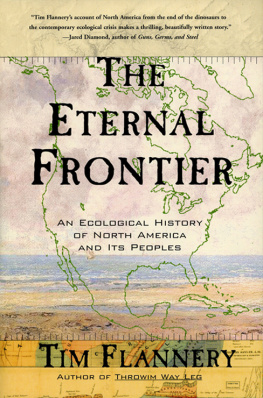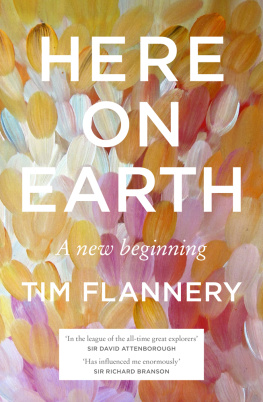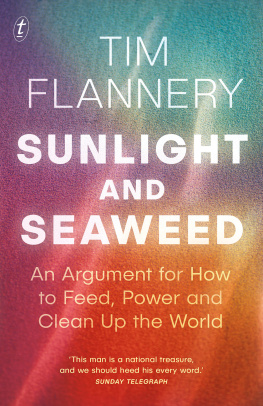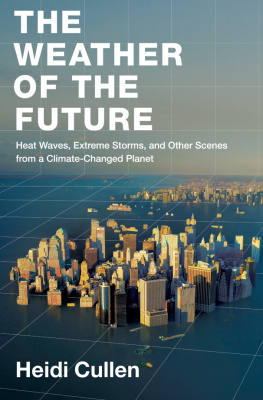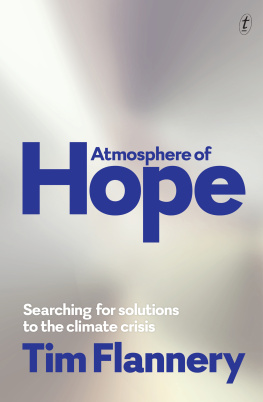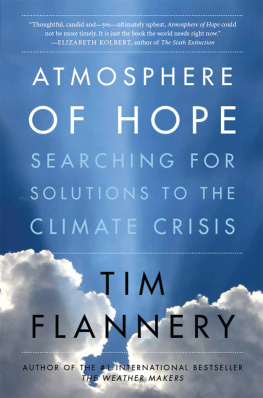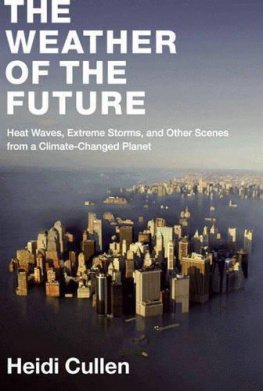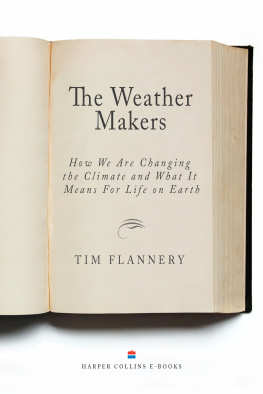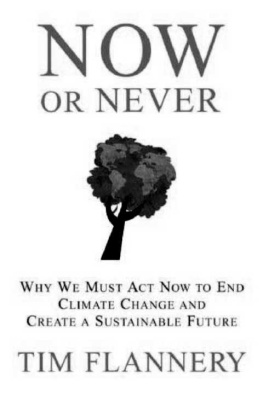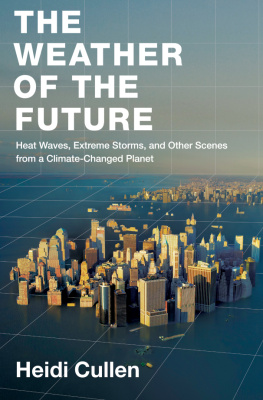PRAISE FOR TIM FLANNERYS
THE WEATHER MAKERS
It would be hard to imagine a better or more important book.
BILL BRYSON
If you are not yet convinced of the gravity of the problem, or our capacity to solve it, you should buy and read this compelling book. Age
The book the world has been waiting for...irrefutable evidence that climate change is already happening, and we need to become very serious about itfast. PETER SINGER
This is the story of global warming. And no one tells it better than Tim Flannery. DAVID SUZUKI
Detail-packed to the point of terrible fascination. New York Times
At last, here is a clear and readable account of one of the most important but controversial issues facing everyone in the world today.
JARED DIAMOND
This is a magnificent bookfull of knowledge we all need and can act upon before its too late. REDMOND OHANLON
The Weather Makers is a book of the utmost importance to everyone on Earth. It is essential reading for the halls of power. RONALD WRIGHT
Flannery gives us a terrifying glimpse of the future.
ROBERT F. KENNEDY, JR.
An overwhelming accountThe Weather Makers shows clearly that decisive action is needed now. CHIEF EMEKA ANYAOKU, PRESIDENT, WWF INTERNATIONAL
All who read The Weather Makers will be left wiser and able to appreciate how fragile our climate is and how it is this generation who must protect it. TONY BLAIR
Tim Flannery is a writer, scientist and explorer. He has published over a dozen books, including the award-winning bestsellers The Future Eaters and The Weather Makers. He is based at Macquarie University, and in 2007 he was Australian of the Year. Tim chairs the Copenhagen Climate Council, is a member of the Wentworth Group of Concerned Scientists, and is the Australasian representative of the National Geographic Society, as well as the director of the Australian Wildlife Conservancy. He lives in a sustainable house on the Hawkesbury River with his wife and a lot of wildlife.
THE
WEATHER
MAKERS
THE HISTORY AND FUTURE IMPACT OF CLIMATE CHANGE
TIM
FLANNERY
WITH A NEW INTRODUCTION
BY THE AUTHOR

TEXT PUBLISHING MELBOURNE AUSTRALIA
The paper in this book is manufactured only from wood grown in sustainable regrowth forests.
The Text Publishing Company
Swann House
22 William Street
Melbourne Victoria 3000
Australia
www.textpublishing.com.au
Text copyright Tim Flannery 2005
Introduction copyright Tim Flannery 2008
All rights reserved. Without limiting the rights under copyright above, no part of this publication shall be reproduced, stored in or introduced into a retrieval system, or transmitted in any form or by any means (electronic, mechanical, photocopying, recording or otherwise), without the prior permission of both the copyright owner and the publisher of this book.
First published by The Text Publishing Company 2005.
This edition published 2008
Reprinted 2009, 2010
Design by Chong
Drawings by Tony Fankhauser
Typeset by J&M Typesetting
Printed and bound by Griffin Press
National Library of Australia
Cataloguing-in-Publication data:
Flannery, Tim, 1956 .
The weather makers: the history and future impact of climate change Tim Flannery
Bibliography.
ISBN 978 1 921351 82 2 (pbk.)
Climatic changes - Effect of human beings on. Climatology - Observations Global warming.
551.6
To David and Emma, Tim and Nick, Noriko and Naomi,
Puffin and Galen, Will, Alice, Julia and Anna, and of course Kris,
with love and hope; and to all of their generation who will
have to live with the consequences of our decisions.
CONTENTS
MAP
Looking back, I was fortunate to start writing The Weather Makers in 20045. By then the science of climate change had developed to the point where the broad areas of concern had already been recognised, allowing me to write a comprehensive overview. In the three years since, no further areas of major concern have been identified, but nevertheless a great deal has happened. Food and oil shortages have occurred much more rapidly than expected, and our climate has been destabilising at a far greater rate than projected.
The bad news on the climate front started to build in 2007, as scientists re-examined the IPCCs climate projections of 2001. With five to six years worth of real-world data available, they discovered that the worst-case scenario of the predictions had been optimistic. Temperature increases, sea-level rise and CO2 accumulation (the key response indicators of climate change) were either at the upper limit of those projections or well beyond them.
By then it was also clear that changes in the Arctic were accelerating beyond all predictions. The major shifts in the Arctic began in the middle of 2005 (as I was putting the finishing touches to this book), when the rate of melt increased fourfold. It has remained high ever since. The summer of 2007 broke all records, and as I write in August 2008 the changes only seem to gather pace. This year the loss of Arctic sea-ice is averaging 6000 square kilometres per week more than that for the same period of 2007. If the pattern of this summers melt is typical of recent decades, by September 2008 the Arctic ice cap will have lost almost half of its extentgoing from 4.2 million to 2.2 million square kilometres. So advanced is the ice loss that Neil Hamilton, Director of the WWF International Arctic Program, recently admitted that We [WWF] are no longer trying to protect the Arctic: it is simply too late.
On 31 March 2008, James Hansen and eight other leading climate scientists published a scientific paper that explained in part why the real-world changes were so dramatically outstripping the climate models. They concluded that, when viewed over the long term, Earths climate system is about twice as sensitive to CO2 pollution as is illustrated in the IPCCs century-long projections, and that there is already enough greenhouse gas pollution in the atmosphere to cause two degrees Celsius of warming, bringing about conditions not seen on Earth for two to three million years.
The scientists also provided a new understanding of how long it takes for the full warming consequences of a given amount of greenhouse gas to be felt. If the delay in planetary heating caused by the oceans alone is taken into account, then we could expect to feel a third of any warming caused by a given amount of greenhouse gas in the first few years after the pollution is produced. Three-quarters of the full warming effect would be felt within 250 years, and all of it within a millennium.
This new information allowed for a reassessment of the climatic tipping point (the point at which the greenhouse gas concentration reaches a level sufficient to cause catastrophic climate change) and the point of no return (when that concentration of greenhouse gas has been in place long enough to begin an irreversible process). Hansen and his colleagues established that we have passed the tipping point and have only a few decades before we reach the point of no return. In summarising their findings, the researchers state: If humanity wishes to preserve a planet similar to that on which civilisation developed and to which life on Earth is adapted, palaeoclimate evidence and ongoing climate change suggest that CO2 will need to be reduced from its current 385 parts per million to at most 350 parts per million.
This year also brought news that the shift away from fossil fuels needs to be larger and faster than previously imagined. IPCC projections guide current thinking about how much greenhouse gas emissions need to be reduced in order to reach certain future targets for atmospheric greenhouse gas concentrations. On 3 April 2008 researchers Roger Pielke, Tom Wigley and Christopher Green published a study examining these projections. Shockingly, they discovered that the task is two-thirds larger than envisaged by the IPCC projections.
Next page

